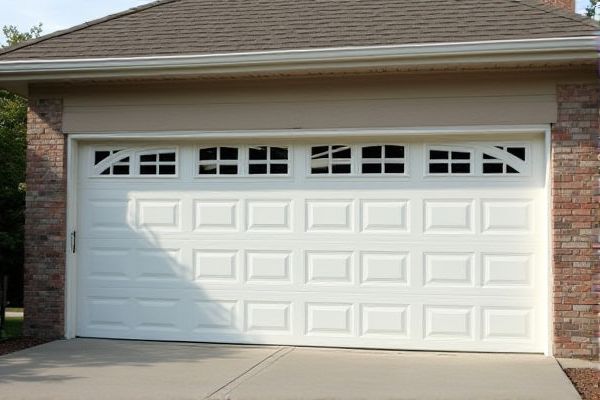
Insulated garage doors provide better energy efficiency and temperature control compared to non-insulated doors, helping to reduce utility bills and protect your belongings from extreme weather. Discover how choosing the right garage door can enhance your home's comfort and value by reading the rest of the article.
Table of Comparison
| Feature | Insulated Garage Door | Non-Insulated Garage Door |
|---|---|---|
| Thermal Efficiency | High - reduces heat loss and gain | Low - poor temperature regulation |
| Energy Savings | Significant - lowers heating and cooling costs | Minimal - no impact on energy use |
| Noise Reduction | Effective - dampens external sounds | Limited - transmits more noise |
| Durability | Enhanced - resists dents and warping | Basic - more prone to damage |
| Cost | Higher upfront investment | Lower initial cost |
| Weight | Heavier due to insulation materials | Lighter, easier to install |
| Climate Suitability | Ideal for extreme temperatures | Suitable for mild climates |
| Maintenance | Low - insulation protects door | Moderate - more exposure to elements |
Introduction to Insulated vs Non-Insulated Garage Doors
Insulated garage doors provide enhanced thermal resistance, reducing heat loss and improving energy efficiency compared to non-insulated doors. Typically made with polyurethane or polystyrene cores, insulated doors also offer better noise reduction and increased durability. Non-insulated garage doors, usually constructed from single-layer steel or aluminum, are less expensive but do not provide the same level of temperature control or soundproofing.
What Is an Insulated Garage Door?
An insulated garage door features layers of insulation material, such as polystyrene or polyurethane, sandwiched between the door panels to improve thermal efficiency and soundproofing. This insulation helps maintain stable indoor temperatures, reducing energy costs and providing a more comfortable environment in your garage. Compared to non-insulated garage doors, insulated options offer enhanced durability and resistance to dents and weather damage.
What Is a Non-Insulated Garage Door?
A non-insulated garage door consists of a single layer of metal or wood without any added insulation material, which makes it less effective at regulating temperature and reducing noise. These doors are typically lighter, more affordable, and easier to install but can lead to higher energy costs and less comfort in your garage space. Choosing a non-insulated door might suit garages used mainly for storage, where temperature control is not a priority for your intended use.
Comparing Energy Efficiency
Insulated garage doors provide superior energy efficiency compared to non-insulated doors by reducing heat transfer and maintaining a more stable indoor temperature. With R-values typically ranging from 6 to 18, insulated doors help lower heating and cooling costs, while non-insulated doors offer minimal thermal resistance. Choosing an insulated garage door enhances your home's overall energy conservation and comfort year-round.
Impact on Home Temperature Regulation
Insulated garage doors significantly improve home temperature regulation by reducing heat transfer between the garage and living spaces, maintaining warmer interiors in winter and cooler conditions in summer. Non-insulated doors allow more air exchange, leading to higher energy consumption for heating or cooling and less consistent indoor temperatures. Choosing insulated doors enhances overall energy efficiency and comfort by acting as an effective thermal barrier.
Noise Reduction Capabilities
Insulated garage doors significantly enhance noise reduction by incorporating materials like foam or polystyrene, which absorb sound and minimize external and internal noise transmission. Non-insulated garage doors lack this sound-dampening layer, allowing more noise to pass through, making them less effective for noise control. Choosing an insulated garage door can improve your garage's comfort by reducing echoes and external disturbances.
Durability and Maintenance Considerations
Insulated garage doors typically offer enhanced durability due to their robust construction with materials like steel and insulation cores, reducing wear from external elements and minimizing dents. Non-insulated doors may require more frequent maintenance as they are more susceptible to damage from weather fluctuations and temperature changes. Choosing an insulated garage door can protect Your garage's interior and reduce long-term maintenance costs by providing better resistance against impacts and environmental stress.
Cost Differences and Value
Insulated garage doors typically cost 15-30% more than non-insulated options due to added materials like foam or polystyrene. Despite higher upfront costs, insulated doors provide better energy efficiency, reducing heating and cooling expenses over time, which adds significant long-term value. Considering your climate and garage usage can help determine if the initial investment in insulation translates into meaningful savings and increased comfort.
Aesthetic and Design Options
Insulated garage doors offer enhanced aesthetic and design options, including a variety of panel styles, finishes, and colors that maintain their appearance over time due to resistance to dents and warping. Non-insulated garage doors typically feature simpler designs with fewer customization choices, often made from thinner materials that can show wear more quickly. Choosing insulated options allows homeowners to achieve a more polished and durable look that complements modern architectural styles.
Choosing the Right Garage Door for Your Needs
Insulated garage doors provide superior temperature regulation and energy efficiency, making them ideal for homes in extreme climates or for garages used as workspaces. Non-insulated garage doors are typically more affordable and lighter, best suited for detached garages or areas with mild weather. Understanding your climate, garage usage, and budget will help you choose the right garage door to enhance comfort and reduce energy costs.
 homyna.com
homyna.com